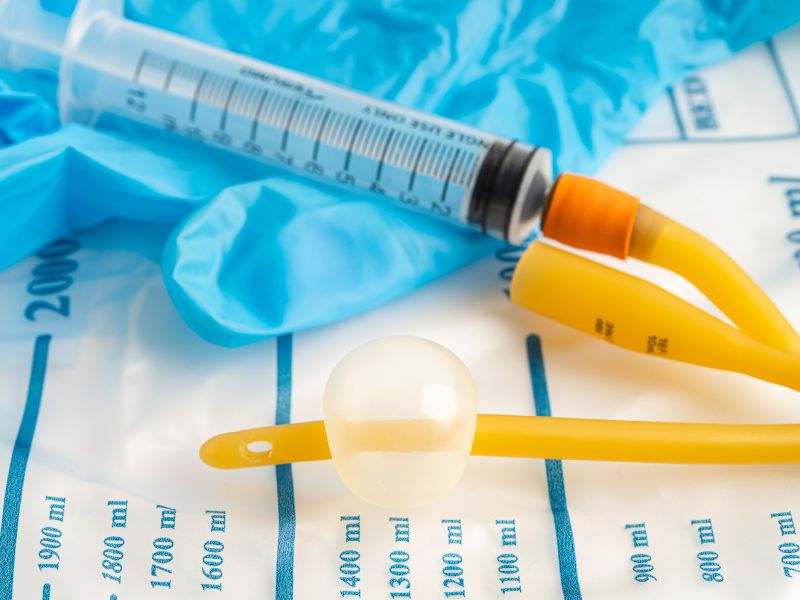Urinary catheters are often a critical tool for individuals managing urological conditions. But with multiple types of catheters available, how do you know which is right for you? Two of the most common types are intermittent catheters and indwelling (Foley) catheters. Understanding their differences can help you make informed decisions with your healthcare provider and find the right solution for lasting comfort. Here’s a breakdown of what you need to know about these two options, including pros, cons, and the conditions they treat.
What Are Intermittent Catheters?
Intermittent catheters are single-use devices that are inserted temporarily to drain the bladder and then removed and discarded. They are typically used several times a day depending on your specific medical needs. Intermittent catheters come in a range of types, sizes and styles to offer tailored comfort and align with your specific activity needs and preferences.
Pros:
- Lower infection risk: Since the catheter is removed after each use, the chances of developing a urinary tract infection (UTI) are lower than with an indwelling catheter.
- Convenient and portable: Intermittent catheters are lightweight and discreet, making them easy to carry and use on the go.
- Preserves bladder function: These catheters allow the bladder to empty fully but still encourage the bladder muscles to function naturally between uses.
Cons:
- Frequent use required: You’ll need to catheterize multiple times daily, which may take some getting used to.
- Learning curve: Some individuals may need training to use them comfortably and effectively.
Common Conditions Treated:
- Bladder incontinence
- Spinal cord injuries
- Neurogenic bladder
- Post-surgery bladder management
What Are Indwelling Catheters?
Indwelling catheters, also known as Foley catheters, remain in place for longer periods, typically anywhere from a few days to several weeks. They are held in place by a small balloon inflated inside the bladder and drain continuously into a collection bag.
Pros:
- Convenience: They provide constant bladder drainage, reducing the need for frequent catheterization.
- Good for long-term use: Ideal for patients with limited mobility or those recovering from surgery.
- No self-catheterization needed: A healthcare professional often places and manages the catheter.
Cons:
- Higher infection risk: Since the catheter remains inside the body, there’s an increased risk of UTIs or other infections.
- Discomfort: Long-term use may cause irritation or discomfort.
- Limited mobility: The collection bag can make moving around less convenient.
Common Conditions Treated:
- Severe urinary retention
- Prolonged immobility
- Chronic incontinence
- Certain surgical recovery scenarios
Which Option Is Right for You?
The choice between intermittent and indwelling catheters often depends on your specific medical condition, personal preferences, and lifestyle.
Intermittent catheterization often provides greater independence and fewer complications compared to indwelling catheters. Here’s why many healthcare providers recommend them:
- Lower risk of urinary tract infections
- More normal lifestyle and intimate relationships
- Greater bladder control and potential for maintaining bladder health
- Easier to conceal and manage during daily activities
- Less interference with work and social life
While intermittent catheterization is often preferred, indwelling catheters may be necessary in certain situations:
- During recovery from certain surgeries
- For patients with limited mobility or dexterity
- In cases of severe urinary incontinence
- When continuous bladder drainage is required
- For short-term use in hospital settings
While indwelling catheters are better suited for long-term or constant use, intermittent catheters offer greater flexibility, lower infection risks, and better overall bladder health.
Why Choose America’s Best Care Plus for Intermittent Catheters?
At America’s Best Care Plus, we specialize in delivering intermittent catheters directly to your doorstep. With a variety of styles, shapes, and sizes available, we make it easy to find the right product for your needs. Plus, our team of experts is here to answer your questions and help you choose the perfect catheter for your lifestyle.
Contact America’s Best Care Plus today to learn more about our catheter supply program and how we can make managing your urological care easier and more convenient. Our friendly team is ready to answer your questions and help you get started with home delivery of your catheter supplies.
Related Reading:
6 Most Commonly Asked Questions About Intermittent Catheters

